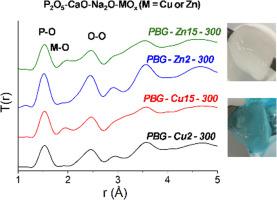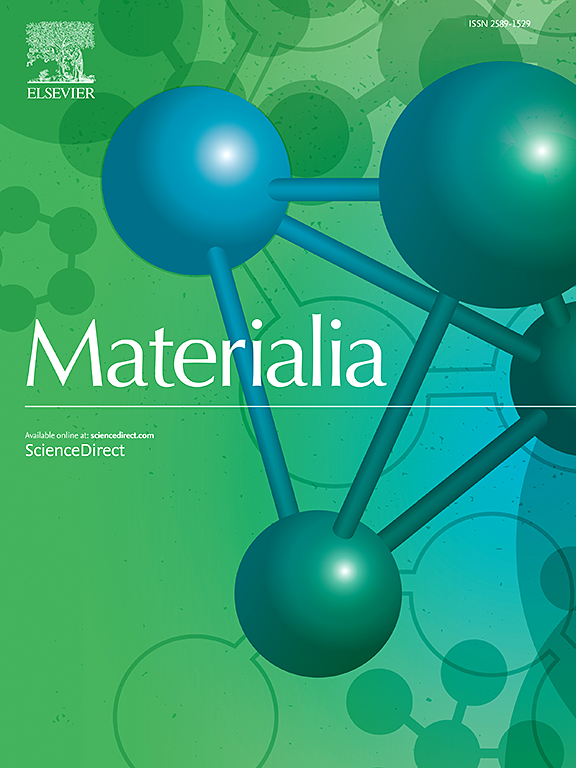Atomic scale investigation and cytocompatibility of copper and zinc-loaded phosphate-based glasses prepared by coacervation
IF 3
Q2 MATERIALS SCIENCE, MULTIDISCIPLINARY
引用次数: 0
Abstract
Phosphate-based glasses (PBGs) are bioresorbable materials that find application in the field of controlled drug delivery and tissue engineering. The structural arrangements of the phosphate units in PBGs, along with the knowledge of how therapeutic metallic ions are embedded in the phosphate network are important in understanding the degradation and targeted release properties of these materials. Using a combination of Raman spectroscopy, high-energy X-ray diffraction and 31P and 23Na solid-state magic angle spinning nuclear magnetic resonance, the atomic structure of coacervate PBGs in the system P2O5-CaO-Na2O-MOx (M = Cu or Zn) with loadings of 2, 10 and 15 mol % of M2+ have been studied as functions of composition and calcination temperature. After drying at room temperature, the structures of the phosphate network in PBG-Cu and PBG-Zn are quite similar, with that of PBG-Zn exhibiting slightly higher connectivity. Heating at 300 °C causes degradation of the polyphosphate chains, even though Q2 species remain predominant. X-ray photoelectron spectroscopy demonstrates that Cu in calcined PBGs is present in both oxidation states +1 and +2, with a predominance of the +2 state. Cu and Zn ion release data after 24 h exposure of PBGs in deionized water and cell medium DMEM show that release is proportional to their loadings. Cytotoxicity MTT assays of dissolution products of PBG-Cu/ZnX calcined at 300 °C on human osteosarcoma cells (MG-63) and on human skin cells (HaCaTs) showed good cellular response for all compositions, indicating that PBGs have great potential for both hard and soft tissue regeneration.

共凝制备的铜锌负载磷酸盐玻璃的原子尺度研究和细胞相容性
磷酸盐基玻璃(PBGs)是一种生物可吸收材料,可应用于可控药物输送和组织工程领域。磷酸盐玻璃中磷酸盐单元的结构排列以及治疗用金属离子如何嵌入磷酸盐网络的知识,对于了解这些材料的降解和定向释放特性非常重要。我们结合拉曼光谱、高能 X 射线衍射以及 31P 和 23Na 固态魔角旋转核磁共振技术,研究了 P2O5-CaO-Na2O-MOx(M = 铜或锌)体系中 M2+ 含量为 2、10 和 15 摩尔% 的共包被 PBGs 的原子结构与成分和煅烧温度的函数关系。在室温下干燥后,PBG-Cu 和 PBG-Zn 中的磷酸盐网络结构非常相似,其中 PBG-Zn 的连通性略高。在 300 °C 下加热会导致多磷酸链降解,尽管 Q2 种类仍占主导地位。X 射线光电子能谱显示,煅烧过的 PBG 中的铜以+1 和 +2 两种氧化态存在,其中以 +2 态为主。铜和锌离子在去离子水和细胞培养基 DMEM 中暴露 24 小时后的释放数据表明,释放量与负载量成正比。在 300 °C 煅烧 PBG-Cu/ZnX 的溶解产物后,对人骨肉瘤细胞(MG-63)和人皮肤细胞(HaCaTs)进行的细胞毒性 MTT 分析表明,所有成分都有良好的细胞反应,这表明 PBGs 在硬组织和软组织再生方面都有巨大潜力。
本文章由计算机程序翻译,如有差异,请以英文原文为准。
求助全文
约1分钟内获得全文
求助全文
来源期刊

Materialia
MATERIALS SCIENCE, MULTIDISCIPLINARY-
CiteScore
6.40
自引率
2.90%
发文量
345
审稿时长
36 days
期刊介绍:
Materialia is a multidisciplinary journal of materials science and engineering that publishes original peer-reviewed research articles. Articles in Materialia advance the understanding of the relationship between processing, structure, property, and function of materials.
Materialia publishes full-length research articles, review articles, and letters (short communications). In addition to receiving direct submissions, Materialia also accepts transfers from Acta Materialia, Inc. partner journals. Materialia offers authors the choice to publish on an open access model (with author fee), or on a subscription model (with no author fee).
 求助内容:
求助内容: 应助结果提醒方式:
应助结果提醒方式:


